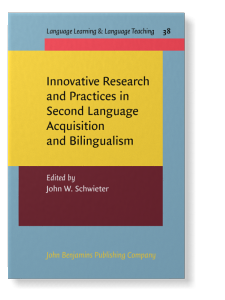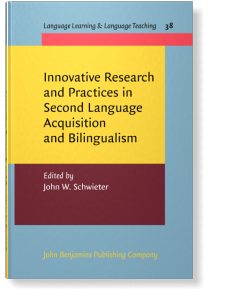Innovative Research and Practices in Second Language Acquisition and Bilingualism
Editor
This volume brings together theoretical perspectives and empirical studies in second language (L2) acquisition and bilingualism and discusses their implications for L2 pedagogy. The book is organized into three sections that focus on prominent linguistic and cognitive theories and together provide a compelling set of state-of-the-art works. Part I consists of studies that give rise to innovative applications for second language teaching and learning and Part II discusses how findings from cognitive research can inform practices for L2 teaching and learning. Following these two sections, Part III provides a summative commentary of the theories explored in the volume along with suggestions for future research directions. The book is intended to act as a valuable reference for scholars, applied linguists, specialists in pedagogy, language educators, and anyone wishing to gain an overview of current issues in SLA and bilingualism.
[Language Learning & Language Teaching, 38] 2013. xiii, 335 pp.
Publishing status: Available
© John Benjamins Publishing Company
Table of Contents
-
Acknowledgments | pp. ix–x
-
PrefaceJohn W. Schwieter and Gabrielle Klassen | pp. xi–xiv
-
Part I. Linguistic perspectives and implications for L2 pedagogy
-
Chapter 1. Mental representation and skill in instructed SLABill VanPatten | pp. 3–22
-
Chapter 2. Input and output in SLA: Applying theories of mental representation and skillWynne Wong | pp. 23–42
-
Chapter 3. Interaction and the Noun Phrase Accessibility Hierarchy: A study using syntactic primingJennifer Behney and Susan M. Gass | pp. 43–62
-
Chapter 4. Generative approaches and the competing systems hypothesis: Formal acquisition to pedagogical applicationDrew Long and Jason Rothman | pp. 63–84
-
Chapter 5. Why theory and research are important for the practice of teaching: The case of mood choice in Spanish relative clausesJoyce Bruhn de Garavito | pp. 85–106
-
Chapter 6. Input-based incremental vocabulary instruction for the L2 classroomJoe Barcroft | pp. 107–138
-
Chapter 7. Experimentalized CALL for adult second language learnersNora Presson, Colleen Davy and Brian MacWhinney | pp. 139–164
-
Chapter 8. Accounting for variability in L2 data: Type of knowledge, task effects, and linguistic structureSilvia Perpiñán | pp. 165–192
-
Chapter 9. The development of tense and aspect morphology in child and adult heritage speakersAlejandro Cuza, Rocío Pérez-Tattam, Elizabeth Barajas, Lauren Miller and Claudia Sadowski | pp. 193–220
-
Part II. Cognitive perspectives and implications for L2 pedagogy
-
Chapter 10. Control and representation in bilingualism: Implications for pedagogyDeanna C. Friesen and Ellen Bialystok | pp. 223–240
-
Chapter 11. Language selection, control, and conceptual-lexical development in bilinguals and multilingualsJohn W. Schwieter and Aline Ferreira | pp. 241–266
-
Chapter 12. Lexical access in bilinguals and second language learnersGretchen L. Sunderman and Eileen Fancher | pp. 267–286
-
Chapter 13. Cognitive foundations of crosslinguistic influenceScott Jarvis, Michelle O'Malley, Linye Jing, Jing Zhang, Jessica Hill, Curtis Chan and Nadezhda Sevostyanova | pp. 287–308
-
Part III. Concluding remarks
-
Chapter 14. Ideas for the practice of instructed SLA and their rationale: A summary and commentaryJames F. Lee | pp. 311–328
-
About the editor | pp. 329–330
-
About the contributors | pp. 331–332
-
Index | pp. 333–335
“This volume is a valuable resource for students, researchers, educators, and curriculum developers and would be a welcome addition to the library of anyone interested in developing and enhancing their knowledge of the relationship between theory and research in SLA and bilingualism and pedagogical practice.”
Nicole Ziegler, University of Hawai’i at Mānoa, in Studies in Second Language Acquisition 36(4), 2013
“Well written and accessible, this volume provides the reader with a thorough overview of some of the more established cognitive and linguistic perspectives in SLA and bilingualism. Although the volume may be most valuable to graduate students, teachers, and curriculum developers looking to enhance their understanding of the processes and products of L2 learning, novice and experienced researchers will find a useful resource in the straightforward discussions of different theories and their direct connections to learning and teaching.[...] Overall, this volume is a valuable resource for students, researchers, educators, and curriculum developers and would be a welcome addition to the library of anyone interested in developing and enhancing their knowledge of the relationship between theory and research in SLA and bilingualism and pedagogical practice.”
Nicole Ziegler, University of Hawaií at Manoa, in Studies in Second Language Acquisition 36(4): 760-761, 2013
Cited by
Cited by 2 other publications
Haser, Verena, Anita Auer, Bert Botma, Beáta Gyuris, Kathryn Allan, Mackenzie Kerby, Lieselotte Anderwald, Alexander Kautzsch, Maja Miličević, Tihana Kraš & Marcus Callies
This list is based on CrossRef data as of 17 june 2024. Please note that it may not be complete. Sources presented here have been supplied by the respective publishers. Any errors therein should be reported to them.
Subjects
Main BIC Subject
CJA: Language teaching theory & methods
Main BISAC Subject
FOR000000: FOREIGN LANGUAGE STUDY / General

